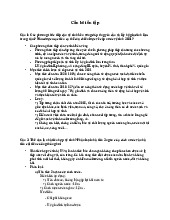



Preview text:
lOMoAR cPSD| 59054137 Introduction
Hello everyone, please allow me to introduce myself ... .. Representing the group
... .. First, I would like to introduce the members of the group in turn including:
Mai Nhat Linh, Vu Nhat Minh and Nguyen Thi Khanh Linh.
Our presentation topic is: COVID-19 and the pandemic impact on Apple's iPhone, Mac and more
Here we will analyze some major difficulties that the company is facing in terms of production and sales. Apple introduction
Founded in 1976, Apple Inc. is currently the number 1 technology corporation that
designs, manufactures, and markets mobile communication and media devices,
personal computers, and portable digital music players. Apple Inc. also sells a variety
of related software, services, third-party digital content, and applications. With
products and services such as iPhone, iPad, Mac, iPod, Apple TV, the iOS and Mac
OS X operating systems, iCloud, and a variety of accessory, service, and support
offerings. The company’s target market is end user consumers, small and mid-sized
businesses, along with education, enterprise and government customers.
Covid19 impact on overall tech environment
The coronavirus (COVID-19) outbreak is causing widespread concern and
economic hardship for consumers, businesses and communities across the globe.
Most companies already have business continuity plans, but those may not fully
address the fast-moving and unknown variables of an outbreak like COVID19.
- Raft of industry event cancellations mean fewer business development opportunities.
- Vastly diminished business travel results in fewer client interactions. -
Production slows as a result of global supply chain disruption.
- Because of the nature of the labor-intensive supply chain of the tech industry,
it was greatly impacted by the pandemic: smartphone production has declined
by 12% YoY in 1Q20, server revenue has declined by 16% YoY in 1Q20. lOMoAR cPSD| 59054137
Coronavirus Impact on Apple's Device Production
- Due to the pandemic, governments around the world have significant
limitations in transportation (land, water and air transport) goods, as well
as in moving labor. Reports show that the use of trucks for distribution
purposes has decreased to 60% since the restrictions in France, 30% before
the pandemic (FAO, 2020J; Bakalis et al., 2020).
- Many of Apple's suppliers in China were forced to shut down production
for several weeks in early February of 2020 , with the factory closures
coming right after the Lunar New Year holiday. Main iPhone suppliers that
include Foxconn and Pegatron were closed for quite some time because an
outbreak of COVID-19 at a supplier campus where workers live in close
quarters would be devastating.
- Apple implemented travel restrictions for its employees, and employees
have not been able to travel to China to begin the preparation process that
takes place ahead of when new flagship iPhones are manufactured. Apple
employees typically travel to China to perfect their manufacturing
processes with partners like Foxconn, and delays ate into the time that
Apple needs to finalize orders for chips and other iPhone components.
- => These facts result in Apple’s supply was unable to meet demands all over the world.
Coronavirus Impact on Apple's Device Sales
- When news of COVID-19 spread since Feburary 2020 to September 2021,
the infection numbers began to rise. Apple shut down all retail stores,
corporate offices, and contact centers in many major cities from all over the world for many weeks.
- Apple sold 494,000 iPhones in China in August, a 61% drop compared to
the 1.3 million the company sold in August of 2020, according to data
released on Monday from China Academy of Information and
Communications Technology (CAICT). Apple hasn't confirmed the sales
data, but the steep decline suggests coronavirus, which has impacted China
more forcefully than any other country in the world, is significantly
affecting Apple's core smartphone business. lOMoAR cPSD| 59054137
- In an interview with Fortune on Monday, Needham & Co. analyst Laura
Martin says Apple's China sales will account for about 15% of the
company's total revenue during the March quarter. And considering the
iPhone accounts for vast majority of Apple's sales, the 61% drop in
Chinese iPhone sales in February, alone, could shave billions of dollars off
Apple's quarterly performance. Some suggestion -
The explosion of Covid-19 also led to difficulty requirements for human
resourcemanagement. These challenges include the changes of working conditions,
applying new workplace policies and actions to reduce human contact (Carnevale
and Hatak, 2020). Therefore, organizations must respond to challenges with some
measures. First, Covid-19 symptoms of workers, visitors, suppliers and contractors
should be monitored before entering the facility. Food safety teams or HACCP teams
can perform temperature screening of all employees at the entrance of the factory.
Monitoring workers wearing face protection and gloves are also important. -
Warehouses and processing facilities should be redesigned to allow
employees to make social ways. Building partitions or barriers including the upper
part of the worker body can be used to maintain social distance. -
Robot machines can also be used to reduce the risk related to Covid-19
workers during coronavirus outbreaks. Moreover, robots can replace people in food
processing activities to maintain social spacing by reducing the number of employees. Conclusion
These are the main sources used to prove the points in our presentation
Clover, J. (2020). COVID-19 Coronavirus: Impact on Apple's iPhone, Mac and WWDC
[Online] Accessed on September 27th, 2021
Martin, L. (2020). iPhone sales drop 61% year-over-year, report says, as Apple struggles with coronavirus [Online] lOMoAR cPSD| 59054137
https://fortune.com/2020/03/09/apple-iphone-china-coronavirussales
Accessed on September 27th, 2021
Carnevale, J B, Hatak, I. (2020). Employee adjustment and well-being
in the era of COVID19: implications for human resource management.
Journal of Business Research, 116: 183–187. Google Scholar
FAO (Food and Agriculture Organization of the United Nations) (2020a)
Adjusting business models to sustain agri-food enterprises during
COVID-19 [Online]. http://www.fao.org/3/ca8996en/CA8996EN.pdf.
Accessed on September 27th, 2021
Bakalis, S, Valdramidis, V P, Argyropoulos, et al. (2020). Perspectives from CO+RE: how
COVID-19 changed our food systems and food security paradigms. Current Research in
Food Science, 3: 166–172.Google Scholar
Crisp. (2020). Get a LIVE view into COVID-19 effects on in-store
purchases [Online]. https://www.gocrisp.com/demandwatch. Accessed on September 27th, 2021
Thank you for your time, on behalf of our presentation group we sincerely thank you.


